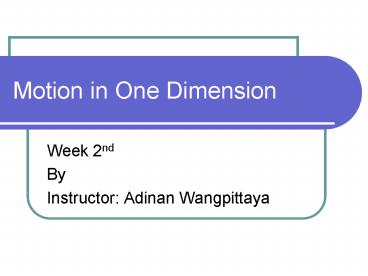Motion in One Dimension - PowerPoint PPT Presentation
1 / 22
Title:
Motion in One Dimension
Description:
Instantaneous Velocity and Speed. The instantaneous velocity vx ... Instantaneous speed of a particle is defined as the magnitude of its instantaneous velocity. ... – PowerPoint PPT presentation
Number of Views:35
Avg rating:3.0/5.0
Title: Motion in One Dimension
1
Motion in One Dimension
- Week 2nd
- By
- Instructor Adinan Wangpittaya
2
Position, Velocity, and Speed
- Position is the location of the object with
respect to a chosen reference point that we can
consider to the origin of a coordinate system. - ...1
- That is displacement or change in position.
- When xf is a final position and xi is an initial
position. - Distance is the length of the path followed by a
particle.
3
Average Velocity
- The average velocity of a particle is
defined as the particles displacement
divided by the time interval during which
that displacement occurs - 2
- Which the subscript x indicates motion along x
axis.
4
Average Speed
- The average speed of a particle, a scalar
quantity is defined as the total distance
traveled divided by the total time interval
required to travel that distance - Average speed ..3
- Its units also same as velocity
5
Example
- Find the displacement, average velocity, and
average speed of the car in Figure between
positions (a) and (F). (Position (a), t (s) 0,
x (m) 30) (Position (F), t (s) 50, x (m)
-53)
6
Instantaneous Velocity and Speed
- The instantaneous velocity vx equals the limiting
value of the ratio as
approaches zero - ..4
- Or
- .5
7
Instantaneous Speed
- Instantaneous speed of a particle is defined as
the magnitude of its instantaneous velocity. - For example, if one particle has an instantaneous
velocity of 25 m/s along a given line and
another particle has an instantaneous velocity of
-25 m/s along the same line, both have a speed of
25 m/s.
8
Acceleration
- The average acceleration of the particle is
defined as the change in velocity divided
by the time interval during which that
change occurs - .6
- The SI unit of acceleration is meters per second
square (m/s2)
9
For Example
- Suppose an object has an acceleration of 2 m/s2.
You should form a mental image of the object
having a velocity that is along a straight line
and is increasing by 2 m/s during every interval
of 1 s. If the object starts from rest, you
should be able to picture it moving at a velocity
of 2m/s after 1s, at 4m/s after 2s and so on.
10
Instantaneous Acceleration
- The instantaneous acceleration was defined as the
limit of the average acceleration as
approaches zero. - ..7
- Or
- ..8
11
Example
- The velocity of a particle moving the x axis
varies in time according to the expression vx
(40-5t2) m/s, where t is on the seconds. - (a) Find the average acceleration in the time
interval t 0 to t 2.0 s. - (b) Determine the acceleration at t 2.0 s.
12
One Dimensional Motion with Constant Acceleration
- A very common and simple type of one-dimensional
motion is that in which the acceleration is
constant. When this case, the average
acceleration over any time interval is
numerically equal to the instantaneous
acceleration at any instant within the
interval, and the velocity changes at the same
rate throughout the motion.
13
Equation 1 (Motion in One Dimension)
- If we replace by ax in the equation of
average acceleration and take t1 0 and tf to be
any later time t, we find that - Or
- ..9
- (For constant ax)
14
Equation 2
- When the acceleration is constant, the graph of
acceleration versus time is a straight line
having a slope of zero. Because velocity at
constant acceleration varies in linearly in time
according to the equation before, we can express
the average velocity in any time intervals as the
arithmetic mean of the initial velocity vxf
- 10
- (For constant ax)
15
Note for the equation
- This expression for average velocity applies only
situations in which the acceleration is constant.
16
Equation 3
- We can now use Equation 1, 2 and 10 to obtain an
object as a function of time. Recalling that
in Equation 2 represents xf xi , and
recognizing that
we find - .11
- (For constant ax)
17
Note for the equation
- This equation provides the final position of the
particle at time t in term of the initial
velocities.
18
Equation 4
- We can obtain another useful expression for the
position of a particle moving with constant
acceleration by substituting Equation 9 into
Equation 11. - 12
- (For constant ax)
19
Note for the Equation
- This equation provides the final position of the
particle at time t in terms of the initial
velocity and the acceleration.
20
Equation 5
- Finally, we can obtain an expression for the
final velocity that does not contain time as a
variable by substituting the value of the t from
the Equation 9 into Equation 11. - .13
21
Note for the Equation
- This equation provides the final velocity in
terms of the acceleration and the displacement of
the particle.
22
For motion at zero acceleration
- We see from Equation 9 and 12 that
- When ax 0
- That is when a of a particle is zero, its
velocity is constant and its position changes
linearly with time.

